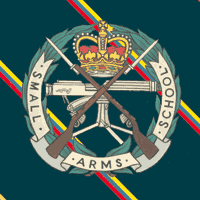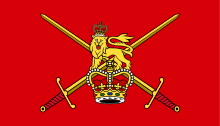Small Arms School Corps
The Small Arms School Corps (SASC) is a small corps of the British Army, established in 1853 by Lord Hardinge.[1] Its personnel provide advice and instruction to infantry weapon trainers throughout the army, in order to maintain proficiency in the use of small arms and support weapons, and in range management.
| Small Arms School Corps | |
|---|---|
 Small Arms School Corps cap badge | |
| Active | 1853 – present |
| Country | |
| Branch | |
| Role | Small arms training |
| Garrison/HQ | Waterloo Lines, Warminster |
| March | March of the Bowmen from the Robin Hood suite |
| Insignia | |
| Tactical Recognition Flash |  |
 |
| Arms of the British Army |
|---|
| Combat Arms |
|
|
| Combat Support Arms |
|
| Combat Services |
|
|
History
Prior to 1838 the majority of British soldiers were issued with the "Brown Bess" Land Pattern Musket, a smooth-bore, muzzle loading black powder flintlock musket which had seen service in one form or another since 1722.[2]
In 1849, Claude-Étienne Minié produced the Minié rifle, although still a muzzle loader three important advances were incorporated. Firstly it utilises a rifled bore; secondly used an expanding bullet that improved accuracy out to 600 yards and greatly reduced reloading time; and thirdly incorporated percussion cap ignition of the black powder charge. Re-equipment of the army with this new firearm, which was adopted in 1851, continued through to 1855.[3]
The consequence of this was that the army now had a weapon that was more accurate, at a longer range, was quicker to load and was marginally safer for the user as to ignition. For the first time since the demise of the bow and arrow, lethal marksmanship was possible. Shooting ceased to be a drill and became an art based on personal skill. Elevation, windage and ballistics now played a part. In order to study these new problems and introduce a shooting doctrine for instruction in Rifle Shooting it was decided to form a special Corps of experts, who would also develop and improve the rifles and those whom use them. In March 1853 the Army Estimates included the sum of £1,000 (about £101,900 today[4]) for Lord Hardinge to form an "Establishment for the instruction of the Army in rifle and target practice."[5]
Foundation

In June 1853 Colonel Hay arrived at Hythe, Kent, with a small staff of officers. On 1 August the first instructor, Colour Sergeant MacKay of the 19th Foot, was appointed. By 15 September a further three instructors were on strength. They were Sergeant Ruston (3rd Battalion Grenadier Guards), Sergeant Lobes (2nd Battalion Grenadier Guards) and Sergeant Morris (97th Regiment).[5] The first mention of the establishment of the School was in the Army List of 1854 when it was referred to as the School of Musketry.[5]
In September 1855 a Corps of Instructors was added to the establishment, consisting of 100 First Class and 100 Second Class Instructors who, as soon as they were sufficiently experienced (except for three who remained at Hythe), were distributed to Depot Battalions and Regiments as required. These men were the Corps of Instructors of Musketry, a misnomer as muskets were being withdrawn from service – yet the art of the use of long arms to this day is sometimes known as musketry.[5]
Later developments
Machine Gun Training Centres had been established in 1914 at Grantham and by the BEF in Wisques, France. This was followed on 14 October 1915 by the creation of the Machine Gun Corps (MGC). Originally equipped with the Maxim gun, these were replaced by the Vickers machine gun shortly after formation of the Corps. In 1919 the name was changed to the Small Arms School.[5]
In 1926 the School expanded to include the Machine Gun School at Netheravon, in 1931 absorbing the Chemical Warfare School at Winterbourne Gunner as the Anti-Gas Wing.[6]
On the occasion of the centenary of the Corps in 1953, March of the Bowmen from the Robin Hood Suite by Frederic Curzon was adopted as the Corps March.[7]
In 1969 the School moved from Hythe to Waterloo Lines (now the Land Warfare Centre) at Warminster,[8] and was joined in 1995 by the wing from Netheravon. Headquarters SASC remains at Warminster to this day.[8]
Badge
The first badge of the School was crossed rifles surmounted by the king's crown. In 1929 the badge merged with that of the Machine Gun Corps, which consisted of two crossed Vickers machine guns, surmounted by the king's crown. This led to the current cap badge being created: a Vickers machine gun, surmounted by a crown and surrounded by a laurel wreath. The title Small Arms School Corps came into being at this time.[1]
Recruitment
The SASC does not recruit directly from civilian life, but only accepts applications from soldiers that are already qualified Skill at Arms (Weapons) Instructors serving in the British Army. All its members hold a minimum rank of Sergeant. Volunteers transfer to the SASC from all Arms and Services, although primarily from the Infantry.[1]
Selection
The training regime is as follows:[9]
Phase 1 – selection and training
The course is planned and conducted by the SASC Training Warrant Officer. The Phase 1 Formative Assessments take place at Waterloo Lines, Warminster and last for 12 weeks. Candidates are assessed to see if they have the ability and capacity to instruct Skill At Arms to the standard required by the SASC. The phase consists of how to train the trainer in the instruction of Small Arms, Defence Train The Trainer Version 2, Command, Leadership and Management training, Live Fire Tactical Training preparation and Small Arms design principles. Candidates are also trained to assess instruction and conduct de-briefs. Their suitability to undertake the role of an SASC Instructor at a Phase 3 Training Centre is also assessed. The candidates conduct the Live Firing Tactical Training (LFTT) course at the Infantry Battle School at Brecon which is an additional five weeks in duration. The LFTT course is conducted either at the end or about halfway through Phase 1. Throughout the process, the candidates are continually assessed in attitude and effort. After Formative Assessments, Candidates then deliver Skill At Arms training to an All Arms Skill At Arms course at the Infantry Battle School, Brecon for 5 days.
Phase 2 – probation
Phase 2 usually takes place at the Infantry Battle School at Brecon. Probationers will instruct, under the guidance and supervision of an SASC Staff Instructor, on the Section Commanders Battle Course or the All Arms NCO Skill at Arms Course. Probationers normally wear the SASC cap badge and rifle Green Beret, but no other regimental insignia. On completion of Phase 2, successful candidates will be transferred to the SASC and awarded their stable belts and regimental shoulder flash.
References
- "Small Arms School Corps". Ministry of Defence. Retrieved 25 December 2015.
- "British land pattern musket". Retrieved 9 May 2014.
- "On the Thin Red Line: Loading and Firing British Muskets during the Crimean War, 1854-1856". Retrieved 9 May 2014.
- UK Retail Price Index inflation figures are based on data from Clark, Gregory (2017). "The Annual RPI and Average Earnings for Britain, 1209 to Present (New Series)". MeasuringWorth. Retrieved 2 February 2020.
- "Early history of the Army School of Musketry in Hythe, Kent" (PDF). Retrieved 9 May 2014.
- "Defence chemical biological radiological and nuclear centre". Retrieved 9 May 2014.
- "The Regimental March". Archived from the original on 12 May 2014. Retrieved 9 May 2014.
- "A Brief Corps History". Small Arms School Corps Comrades Association. Archived from the original on 29 November 2014. Retrieved 20 June 2019.
- "Small Arms School Corps Phase 2 & 3 Training". Retrieved 9 May 2014.
External links
Order of precedence
| Preceded by Royal Army Veterinary Corps |
Order of Precedence | Succeeded by Royal Army Dental Corps |